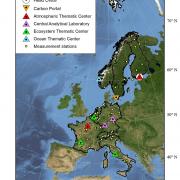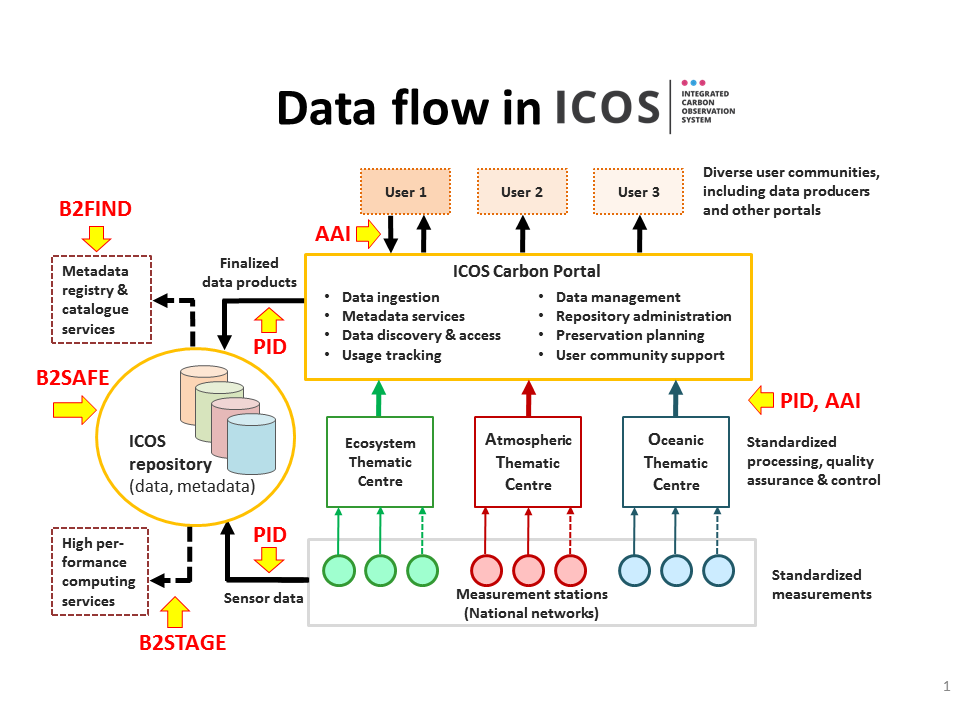
The outcome of the Paris Climate Change Conference at the end of November 2015 is regarded by many as crucial for the future of the Earth. Regardless of what is decided, it will be very important to accurately monitor the concentration of greenhouse gases in the atmosphere over the coming decades.
 Maggie Hellström, from the Department of Physical Geography and Ecosystem Science at Lund University in Sweden, is also a staff member of the Integrated Carbon Observation System (ICOS) Carbon Portal. The portal is the data centre of the ICOS research infrastructure, which plays a vital role in collecting data about greenhouse gases in Europe. Maggie is also involved with ENVRIplus, another Horizon 2020 project, which brings together a number of research infrastructures from the environmental sciences. At the moment, most of Maggie’s time is spent on working with EUDAT as she is the uptake coordinator and service integrator for ICOS. In this interview, Maggie explains about ICOS and the process of integrating the EUDAT services to help make ICOS data more accessible.
Maggie Hellström, from the Department of Physical Geography and Ecosystem Science at Lund University in Sweden, is also a staff member of the Integrated Carbon Observation System (ICOS) Carbon Portal. The portal is the data centre of the ICOS research infrastructure, which plays a vital role in collecting data about greenhouse gases in Europe. Maggie is also involved with ENVRIplus, another Horizon 2020 project, which brings together a number of research infrastructures from the environmental sciences. At the moment, most of Maggie’s time is spent on working with EUDAT as she is the uptake coordinator and service integrator for ICOS. In this interview, Maggie explains about ICOS and the process of integrating the EUDAT services to help make ICOS data more accessible.
Hi Maggie, we know that ICOS is involved with greenhouses gases - would you give us an overview of ICOS and what it does?
ICOS is a pan-European research infrastructure bringing together the atmospheric, ecosystem and oceanic greenhouse gas research communities. Our mission is to quantify and understand the greenhouse gas balance of the European continent and adjacent regions. As of November 2015, ICOS has been given the status of a European Research Infrastructure Consortium (ERIC) by the European Commission. So far nine European countries (Belgium, Finland, France, Germany, Italy, the Netherlands, Norway, Sweden and Switzerland) have signed, and several more are in the pipeline. The main aims of ICOS are to collect high-quality observational data relevant to the greenhouse gas budget of Europe, to make these ICOS data freely available to all interested parties, and to promote the use of the ICOS data for further scientific study. Our work is vital because, if we want the coming generations to have a good life on this planet in the future, we must make sure that we do not destroy the ecosystems and environment. And, to be successful in that, we need to have reliable data showing what is really happening in terms of climate change and greenhouse gases, so that politicians and policy makers have an accurate basis for making well-informed decisions. Those data also need to be openly and freely available to everyone, and they must be stored in a safe way so that they cannot be manipulated.
The main aims of ICOS are to collect high-quality observational data relevant to the greenhouse gas budget of Europe, to make these ICOS data freely available to all interested parties, and to promote the use of the ICOS data for further scientific study. Our work is vital because, if we want the coming generations to have a good life on this planet in the future, we must make sure that we do not destroy the ecosystems and environment. And, to be successful in that, we need to have reliable data showing what is really happening in terms of climate change and greenhouse gases, so that politicians and policy makers have an accurate basis for making well-informed decisions. Those data also need to be openly and freely available to everyone, and they must be stored in a safe way so that they cannot be manipulated.
In terms of our organization, ICOS has a distributed, highly decentralized structure. The map shows the locations of our Head Office, the Carbon Portal data centre, the three Thematic Centres for data analysis, and the supporting Central Analytical Lab. You can also see the member countries and the network of nationally operated measurement stations, with more than 110 stations in total.
 Thanks, Maggie. We’re certainly fortunate in Europe to have ICOS collecting data like that and making it freely available so there is transparency in the way the information is being used to make decisions on emissions and so forth. Would you give us some more details about the kinds of data ICOS works with - where does the data come from, who is making use of the data and what are they using it for?
Thanks, Maggie. We’re certainly fortunate in Europe to have ICOS collecting data like that and making it freely available so there is transparency in the way the information is being used to make decisions on emissions and so forth. Would you give us some more details about the kinds of data ICOS works with - where does the data come from, who is making use of the data and what are they using it for?
ICOS produces quality-controlled observational data, as well as results from modelling related to greenhouse gases, and synthesis reports. These data come from national measurement networks, from our ICOS Thematic Centres and from modellers in the greenhouse gas research community. ICOS data products are used by atmospheric, climatological and environmental researchers for their research and also by policy makers, government agencies and organisations that need to know what is happening in terms of greenhouse gases in order to make decisions for the future. Our data are available to anyone who wants to use them, for example, for educational or commercial purposes.
We produce about 25-30 TB of sensor data per year, along with a bit under 1 GB of processed data products and 5-20 TB of elaborated data products. The ICOS processed data products are mostly time series of observed parameter values, for example carbon dioxide concentrations, given for every 30-minute interval. Every observation station delivers such time series for 50-100 parameters, representing the measurements made every day of every year.
The elaborated products are outputs from different models that describe the combined influence of human activities and natural ecosystem processes on the emission and uptake of greenhouse gases from the Earth’s surface. The results are typically in the form of time series of maps, showing the variation in time and space of, for example, carbon dioxide emissions.
The synthesis reports that I mentioned earlier are summaries of the greenhouse gas balance of the European continent. These are made by combining ICOS results with other information, and are meant to illustrate overall trends and also highlight responses to specific climatic events, such as heat waves or droughts.
At present we are just getting started, but we expect to have around a hundred people actively accessing our larger datasets several times per year, and several hundreds more using smaller volumes of our data.
So ICOS is interested in using some of the EUDAT services to help with those different types of data?
Yes, the diagram below shows the flow of data within ICOS. You can see that we need completely reliable long-term storage for our observational data from our sensor networks. If we lose the greenhouse gas measurements for a particular time frame, there is no way we can go back and measure them again, so we need safe, long-term data storage. For this, we will be using B2SAFE.
The ICOS Carbon Portal will be the actual access point for all the ICOS data products, but of course we want to “advertise” the existence of our data as widely as possible. Here, the B2FIND service will be of great help, allowing users looking for greenhouse gas data to discover our data sets and to access them.
ICOS obviously wants people to easily be able to identify, and refer to, our data. So we will use the B2HANDLE service from EUDAT for identifying our data files. This is a Handle-based persistent identifiers system that makes use of the application programming interface (API) from the European Persistent Identifier Consortium (ePIC). Their API provides a software stack for this service that is sufficiently generic to fulfil the needs of a broad range of different scientific communities. These unique persistent identifiers (PIDs) can then be used as references in articles and reports by people using ICOS data in their research.

In ICOS, data are collected following strict guidelines at measurement stations in the member countries. Stations send their sensor data to the relevant Thematic Centre - atmosphere, ecosystem or marine - for processing and quality control. The results are then passed to the Carbon Portal, which acts as a “one-stop shop” for all ICOS data products. Here users from many different communities can discover, visualize and download data - and some will also contribute their own research results to ICOS! The Carbon Portal is also responsible for the long-term archiving of all data and associated metadata in the ICOS repository. The EUDAT services and features that ICOS would like to use are indicated in red.
Additionally, since our data are used in very complex numerical models of the climate and so forth, we need to be able to move these data to high-throughput computing (HTC) and cloud computing resources, which will be done with B2STAGE. Typically these would, for example, be HTC resources at centres coordinated and federated by the EGI Foundation (formerly the European Grid Initiative). How that will be done for ICOS is being investigated within EUDAT activities focused on cross-infrastructure services (WP7).
We may also explore the possibility of using the B2DROP service as one way for external research groups to upload their elaborated data products for distribution via the ICOS Carbon Portal.
Finally, the B2ACCESS service under development by EUDAT could be of great interest to ICOS, for example for controlling and monitoring access to ICOS-internal IT resources. This AAI (Authentication, Authorization and Identification) service makes it easy to handle lists of users, to check their identity when they log in, and then keep track of which resources and files they are allowed to access in the system.
How is ICOS going about making it possible to start using those EUDAT services, Maggie?
Over the next two years, ICOS members (mainly from Lund University and the University of Helsinki) will be involved with defining the features of the services that we need. The ICOS Carbon Portal (in Lund) will be responsible for coordinating and implementing the uptake process. From the EUDAT side, people from the CSC – IT Center for Science in Helsinki and the PDC Center for High Performance Computing in Stockholm, and possibly from the Jülich Research Centre, will be involved in adapting and integrating the relevant EUDAT services to meet the needs of ICOS.
What we will do is to design, construct (that is, write programs) and make operational all the software components that are needed to transfer data (and its associated descriptive metadata), first internally between the ICOS data centres, and then via the Carbon Portal to the EUDAT facilities. These data transfers need to be as automated as possible, so they can run on their own without human input, and to make this work we must ensure that the ICOS and EUDAT servers can exchange all necessary information safely and efficiently.
In parallel, we are building up the Carbon Portal website, that will enable users to search for, visualize and download all the ICOS data products.
This is a very complicated and technical process, and we will focus on writing up good documentation of our use case and make this available later via the EUDAT website to help other research communities that are looking at adopting EUDAT services!
Thanks very much, Maggie. We look forward to finding out more in the ICOS use case!
